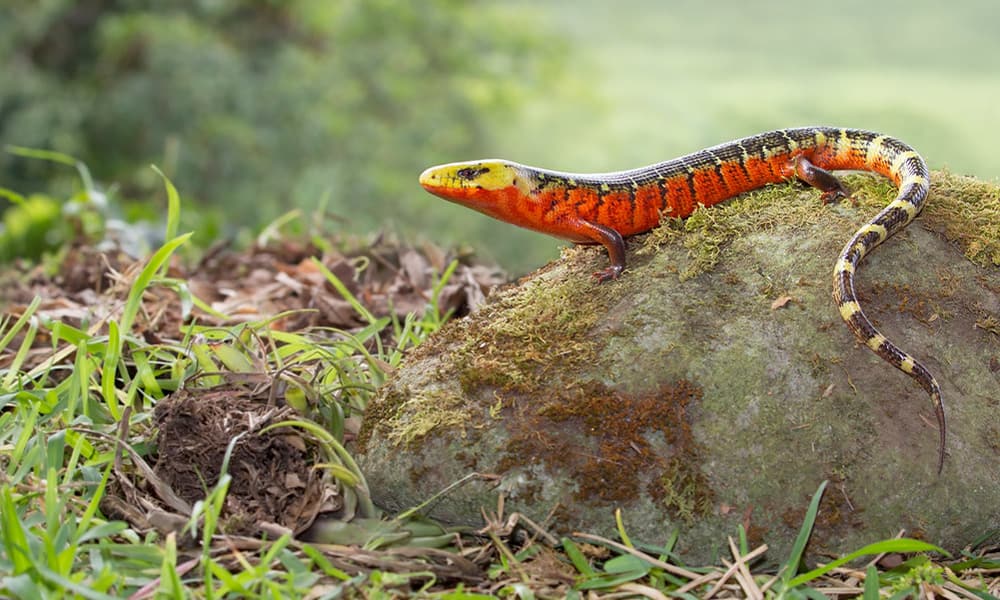The orange-bellied galliwasp is Costa Rica’s most awesome lizard. At least according to an informal survey of myself and my 7-year-old son that just walked by.
They’re awesome for many reasons. For one, the word galliwasp is fantastic. It’s fun to say. And believe it or not the Spanish name is even better, Madre de Culebra. Snake Mother! Come on! They’re also awesome because of the way they look. They have a long, cylindrical, skink-like bodies that look shiny and smooth and the colors are the best part.
Their backs are yellow with dark bands all down the spine and the belly is a very bright orange/red. It’s the kind of bright, hey-look-at-me coloration that you’d expect from a venomous animal (even though it’s not).
I’ve had one fleeting interaction with the orange-bellied galliwasp and it involved a disappointed old man.
I met this particular galliwasp on the farm of Don Federico, the world’s oldest man. I had a contract to do some wildlife monitoring on private farms and one of the farms belonged to Don Federico. Don Federico stood about five feet six inches tall and weighed maybe 110 pounds.
Every time I interacted with him, he was dressed as an old-timey Guanacasteco cowboy complete with stirrups (though the spikey-wheel part of one of the stirrups was always missing). He gave off a solid grumpy old man vibe.
Often times, the most difficult Spanish for me to understand is Spanish being spoken by a very old man. And, probably not surprisingly enough, the people who have the most difficulty understanding my gringo-accented Spanish are very old men. And this was the case with Don Federico and I. We couldn’t really understand each other.
And based on that shaky communication he didn’t really understand the work I was trying to do with the camera traps and seemed to think my work was kind of silly. At the very least, it seemed as though he had other, more important, cowboy-related, things to do.
So on galliwasp-day, Don Federico and I ventured through cow pastures, past neighbors’ barking dogs, under barbed wire fences and into the forest to check the three camera traps that we had placed a month before.
After walking about a hundred meters into the forest, the landscape dropped steeply downward. The cameras were down there, so with Don Federico in the lead, we walked/slid/fell down the forested mountainside toward the area where we had placed the cameras. About 200 meters down the mountain I hear Don Federico shout out, “What’s that?!”
I scoot down the embankment to catchup and see a reptile tail sticking out of some leaves.
I immediately assume it’s some kind of snake, but before I can register what it is, Don Federico starts swinging wildly at it with his machete.
It wiggles out from under the leaves, and I see that it’s a brightly colored lizard, not a snake. Federico’s yelling. “Kill it! Kill it! It’s poisonous!”
He’s swinging away at it with his machete but it’s wiggle-running quickly through the leaflitter and he keeps missing.
I’m not one to swing machetes at reptiles unless it’s absolutely necessary, so I just stand there. He looks at me, clearly put off that I’m not participating in the chop-frenzy, “Kill it! Chop it! It’s poisonous!”
As it wiggles away from him and toward my feet, I get my first good look at it and as soon as I see it, my brain says ‘Galliwasp! That’s a galliwasp!’
At least I think it is. I’d never seen one before, but I remembered seeing a picture of a big multicolored lizard in my Costa Rica reptiles book, and I think the name was galliwasp.
“Chop it! It’s poisonous!” he’s yelling while aggressively stabbing at the leaves. “It’s not poisonous!” I’m saying back to him. At least I think it’s not. There are very few poisonous lizards in the world, and I didn’t remember ever hearing about one in Costa Rica.
He takes a few more feeble jabs at a pile of leaves but it seems as though it got away. With the excitement now past, we now lean back and take stock of the situation.
“In 50 years on this farm, I’ve never seen one of those before. What was it?”
I shrug my shoulders. If you think I’m about to say a silly word like ‘galliwasp’ to a hundred-year-old man who already thinks I’m a bit of a dope, you’ve got another thing coming.
About the Author
Vincent Losasso, founder of Guanacaste Wildlife Monitoring, is a biologist who works with camera traps throughout Costa Rica. You can contact him at: vincent@guanacastewildlifemonitoring.com

